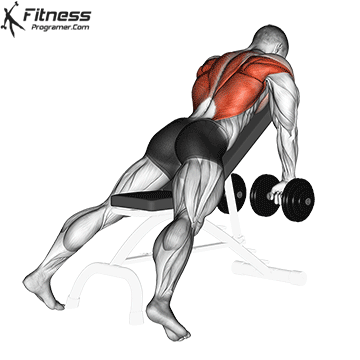45 Degree Incline Row
The 45-degree incline row is a variation of the classic bent-over row exercise that targets the upper back muscles. In this exercise, the upper body is positioned at a 45-degree angle, which allows for a different angle of pull and increases the focus on the upper back muscles, particularly the posterior deltoid, rhomboids and trapezius muscles. The exercise is typically performed with dumbbells or a barbell, and involves pulling the weight towards the chest while keeping the elbows close to the body.
How to do:
- Set an adjustable bench at a 45-degree angle and lie face down with your chest against the bench, and your feet flat on the ground.
- Pick up two dumbbells or a barbell with an overhand grip, and let your arms hang straight down towards the floor.
- Exhale and lift the dumbbells or barbell towards your chest while keeping your elbows close to your body.
- Pause for a second at the top of the movement and squeeze your shoulder blades together.
- Inhale and lower the weight back down towards the starting position.
- Repeat for the desired number of repetitions.
Progressive Overload: To build muscle and increase strength, it’s important to gradually increase the resistance or weight used during the exercise. The 45-degree incline row can be performed with dumbbells, barbells, or other types of resistance, allowing for progressive overload and muscle growth over time.
45 Degree Incline Row – Benefits
1- Enhances Muscle Activation: The 45-degree incline row is a compound exercise, which means it engages multiple muscle groups and joints. Compound exercises are effective for building overall strength and muscle mass, as they allow for more weight to be lifted and more muscles to be worked in a single movement. The 45-degree incline row can enhance muscle activation in the upper back muscles, leading to improved muscle growth and strength. By focusing on proper form and engaging the targeted muscles during the exercise, you can maximize the benefits of this exercise for muscle building and upper body strength.
2- Improves Upper Body Function: The 45-degree incline row is an effective exercise for building muscle and increasing upper body strength. Strong upper back muscles are essential for performing a variety of upper body movements, such as pull-ups, rows, and overhead presses. By improving upper back strength with the 45-degree incline row, you can enhance your overall upper body function and performance.
3- Improves Posture: Improving posture is a common goal for many people who are interested in maintaining good health and reducing the risk of pain or injury. Poor posture can lead to a number of health problems, including back and neck pain, headaches, and decreased mobility. Fortunately, the 45-degree incline row is a great exercise for improving posture, and here are some reasons why:
- Targets the Upper Back Muscles: The 45-degree incline row is a great exercise for targeting the upper back muscles, including the rhomboids and trapezius. These muscles are responsible for keeping the shoulders back and down, which is an important component of good posture.
- Emphasizes Scapular Retraction: During the 45-degree incline row, the scapulae (shoulder blades) are retracted, which helps to strengthen the muscles that hold the shoulders back and down. This can help to correct the rounded shoulders that are commonly associated with poor posture.
45 Degree Incline Row – Muscles Worked
The 45-degree incline row primarily works the muscles of the upper back, specifically the posterior deltoids, traps, Infraspinatus and rhomboids. In addition to these primary muscles, the 45-degree incline row also works the biceps and forearms muscles. The biceps and forearms are engaged during the pulling motion, while other muscles are used to stabilize the spine and maintain proper form.
Here’s a breakdown of the muscles worked during the 45-degree incline row:


